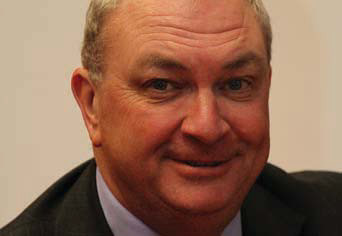2019 Predictions
16 January 2019The New Year is here but what will it bring? The big current issue is, of course, the nature of the UK’s exit from the EU on March 29. We are likely to find out very soon whether we are heading for deal or no deal. Trading and customs arrangements, currency, housebuilding, investment decisions and general business confidence could all be affected in the coming months. But there is some optimism in timber sectors, with the UK sawmilling sector seeing opportunities to grow its share of the UK timber market and others predicting some stability. Here we ask several industry figures for their 2019 expectations
Currencies face political headwinds
Phil McHugh is chief treasury analyst at Currencies Direct
2018 was a shaky year for the financial markets and for timber-related currencies. The pound has been dominated by Brexit and has been a key barometer for ongoing Brexit developments. We now look to 2019 and to January for any further developments between the UK and the EU to get May’s deal over the line ahead of the meaningful vote in parliament. We still see more chance of a deal being agreed and this should see a sizeable relief rally in the pound, which has a long runway to aim at following the erosion of its value since the referendum in 2016. If the tide shifts to a no deal outcome then we can expect to see a further 10% fall in the pound.
The euro had a difficult 2018 with disappointing growth and the confrontation with Italy and the EU highlighting fault lines. Additionally the European Central Bank (ECB) has made it clear that hikes are not imminent and we look to the back end of 2019 at the earliest. This year should bring more cheer for the euro as we move closer to ECB normalisation. A recovery in the eurozone supported by higher real wage growth, better trade performance and expansionary fiscal policies could lower elevated equity risk premiums in Europe and support the undervalued euro.
It was a strong year for the US dollar and we closed the year with another rate hike from the Federal Reserve. However, looking ahead to this year we see scope for US dollar weakness as interest rates are moving to neutral. We expect only two hikes in 2019, which will help settle emerging markets and remove a key anchor for US dollar strength. In addition, the ceasefire between China and the US on trade should allow for completion of a deal that will help lift global growth and reduce perceived risk. We see euro/US dollar moving back up towards 1.20 in 2019.
The Riksbank in Sweden has just lifted interest rates from -0.25% to -0.5%, which is the first hike since 2011 and it states the next rise will likely happen in the second half of this year, with two hikes a year following the next hike. The rise in rates was a close call and the Swedish krona has rallied on the news. Looking ahead, however, there are still headwinds. The fall in oil prices and the weaker housing and signs of a peak in economic indicators risk a move lower for the Swedish krona in 2019.
In summary, 2018 was a tough year and we have seen heightened volatility and nervousness dominate the financial and currency markets. On balance, 2019 should see some big concerns ease in our view with a deal on Brexit and between China and the US. We expect a stronger pound and some uplift for the euro whilst a reversal of US dollar strength is on the cards. The Swedish krona is dancing a difficult path with a risk of spinning to the downside.
Housing to remain a government priority
Stewart Baseley is executive chairman of the Home Builders Federation
The past five years have seen an unprecedented 78% increase in housing supply and the industry has been investing heavily in the land, people and supply chain needed to go even further.
We have been under supplying housing in this country for decades and have an acute shortfall that has led to an underlying demand for more new homes. Successive governments have realised the need to create an environment where more can be built, and this has been key to the increases we have seen.
Help to Buy is probably the best example of this. The scheme is enabling people, mostly first-time buyers, to buy a new build home, which in turn is providing builders with the confidence in future demand that is needed for them to invest.
Planning permissions demonstrate this confidence. Over 350,000 plots a year are now getting an initial planning permission – the highest on record. Whilst these still have to navigate the complexities of the planning system they demonstrate the commitment of the industry to deliver further increases in supply in the coming years.
The big unknown is the impact Brexit, whatever shape it eventually takes, might have on consumer confidence and the market. However, one prediction I will make is that, irrespective of Brexit, housing will remain a key priority for government – regardless of who is in power – and as a country we will seek to increase output even further to address the underlying housing shortage.
Focus on delivery, not punditry
Tony Hackney is chief executive officer of BSW Timber
2019 is going to be an interesting year where I think Brexit issues will have an unsettling impact on market conditions.
It is my opinion that we will see a strong position for UK sawmillers who are prepared to show loyalty to their customer base.
The impact of weaker demand globally will also determine the success for our sub-sector this year, against the backdrop of supply chain constraints to serve a greater demand in the UK.
I believe that purchasers of sawn timber will feel unsettled this year and as a major supplier we have to give comfort that we are able to deliver on time in full to all our accounts. This will need a strong vision and focus on business and just delivering, rather than worrying about what the pundits say about poor construction activity.
We have to create our own markets here in the UK and let’s not forget we have over two years of mediocre fencing activity, which is bound to have created a pent up demand.
Prospects for joinery
Andrew Madge is managing director of Gowercroft Joinery
Prospects for the joinery industry in 2019 will be hard to predict until current Brexit negotiations are concluded and the shape of our future relationship with Europe is agreed.
Until then we can only hope that levels of business confidence and investment can be maintained throughout the sector and that any fallout from a possible decline in sterling and the economy as a whole can be mitigated.
In terms of the windows and door market and consumer sentiment, I would expect to see the continued trend towards using natural and sustainable materials, as well as an increased focus on the overall performance and longevity of products.
It looks like the Healthy Buildings agenda will continue gaining traction and the public will continue the shift away from synthetic materials and particularly the use of plastic in the home.
This is all positive news for the woodworking industry, which has demonstrated exceptional performance and truly natural, sustainable credentials.
As a business, Gowercroft Joinery is growing steadily and has invested heavily in its manufacturing capacity ready for 2019.
There is no question that the outcome of the Brexit vote may have an impact on the future growth in this sector, but as a forward-thinking and nimble company, I believe we can prepare for most eventualities and be in a position to take advantage of any opportunities that may present themselves once the dust has settled.
Difficult first half ahead
John Griffiths is managing director of SCA Wood UK
Whilst positive UK GDP growth is currently forecast for 2019, on the basis of a controlled exit from the EU, we do, however, enter unprecedented and uncertain times from both a political and economic perspective.
With business and consumer confidence declining, the UK is experiencing the impact of the uncertainty in our financial market.
The flat growth expected over the next year will be significantly influenced by the trading agreement and customs arrangements that are negotiated as part of Brexit.
At SCA we have taken measures to protect our product supply from the initial impact of a hard Brexit. We cannot predict the eventual outcome based upon the current turmoil and the wider unsettled global economy.
We have assumed that H1 2019 will be a difficult trading period until the UK’s status post hard/soft Brexit is fully understood.
The current situation has not affected our investment, recruitment or business development planning but once we have a clear view of the trading activity we can adjust our business plan accordingly if required. SCA remains cautious until the current situation has been clarified.
Stable market predicted for UK
TTJ’s softwood specialist
As the trade entered 2019, two opposing factors combined and created a stable backdrop to the imported C24 market.
As demand in Q4 slowed, an easement in price emerged, but against downward movement, Brexit uncertainties caused sterling to drop in November from a Q4 high of €1.15/£1 down to 1.10, settling at around 1.11. This swing of nearly 4.5% resulted in an average reduction of 2.3% in the value of sterling against the euro with similar movements against the Swedish krona. This situation had the effect of neutralising UK market prices, leaving a flat but firm market to carry into Q1 of this year.
In terms of general softwood supply, combined Baltic global exports are estimated to hit around 4.5 million m3 – a small drop of 0.6% – while Sweden may increase global exports by just over 1% to 13.15 million m3.
Finland’s exports are predicted to rise by over 2% to 9.45 million m3 and German producers predict a repeat of 2018 at 8.5 million m3. German consumption is expected to stay at 19.5 million m3, which will still leave them as the largest user in Europe.
UK demand has been projected to grow by a small volume with increased home-grown supply, but softwood imports are expected to stay flat at 6.68 million m3. (Figures taken from UNECE COFFI 2018 projections).
With this backdrop the UK market should progress in a stable manner. There is no apparent danger of over-production to flood the market, but a lot will depend on demand.
European markets are poised for growth around 0.75%, and in spite of recent turbulence in the US markets, softwood prices have bottomed out and consumption and imports are predicted to show some growth.
China will have a bearing on global demand, but most softwood shippers seem confident that overall 2019 will take a positive turn.




